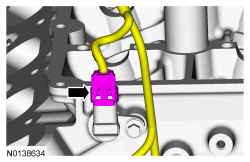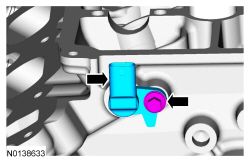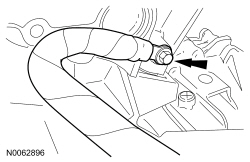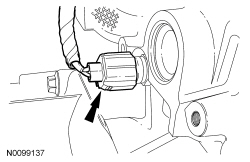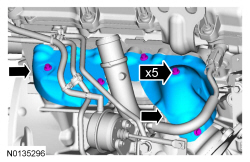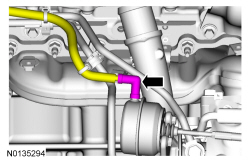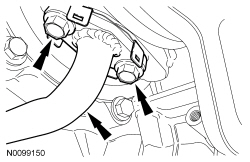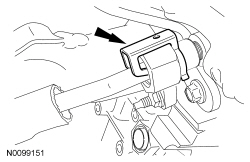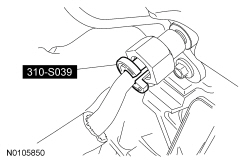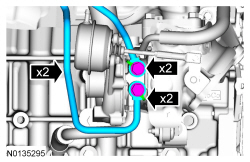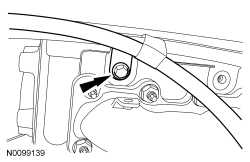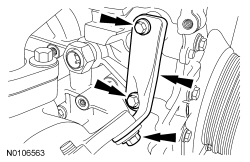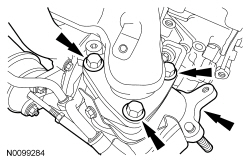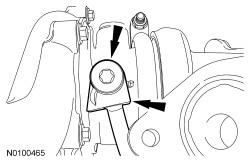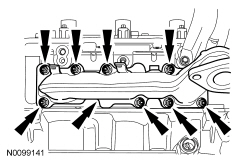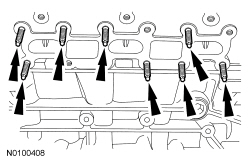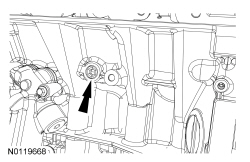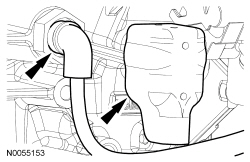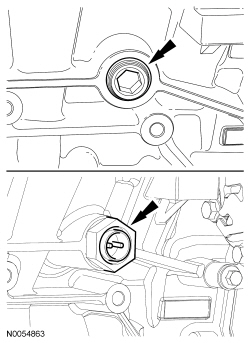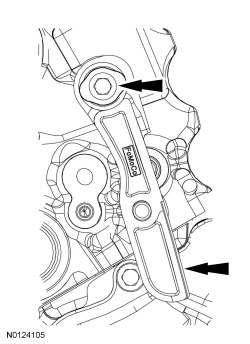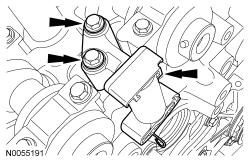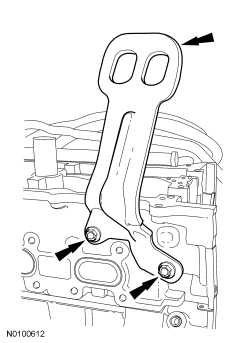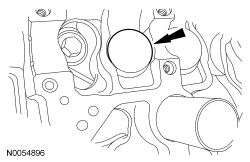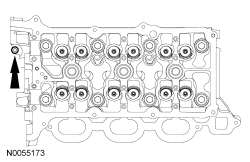SECTION 303-01B: Engine — 3.5L GTDI
| 2014 Flex Workshop Manual
|
REMOVAL
| Procedure revision date: 05/02/2013
|
Cylinder Head — RH
Special Tool(s)
 | Spring Lock Coupling Disconnect Tool
310-S039 (T90T-9550-S) or equivalent
|
Material
| Item
| Specification
|
|---|
Motorcraft® Metal Surface Prep
ZC-31-A
| —
|
Motorcraft® Silicone Gasket Remover
ZC-30
| —
|
NOTICE:
During engine repair procedures, cleanliness is extremely important. Any foreign material, including any material created while cleaning gasket surfaces, that enters the oil passages, coolant passages or the oil pan, may cause engine failure.
NOTICE:
Whenever turbocharger air intake system components are removed, always cover open ports to protect from debris. It is important that no foreign material enter the system. The turbocharger compressor vanes are susceptible to damage from even small particles. All components should be inspected and cleaned, if necessary, prior to installation or reassembly.
- Remove the fuel rails. For additional information, refer to
Section 303-04B
.
- Remove the RH camshafts. For additional information, refer to
Camshaft
in this section.
- Disconnect the RH Camshaft Position (CMP) sensor electrical connector.
- Remove the bolt and the RH
sensor.
- Remove the bolt and the ground wire.
- Disconnect the Cylinder Head Temperature (CHT) sensor electrical connector from the rear of the RH cylinder head.
- Remove the 5 bolts and the 2 upper RH exhaust manifold heat shields.
- Disconnect the turbocharger wastegate regulating valve hose from the RH turbocharger assembly.
- Remove the 2 bolts and the turbocharger oil return tube from the RH turbocharger.
- Remove and discard the gasket.
- Remove the oil supply tube secondary latch.
- Using the Spring Lock Coupling Disconnect Tool, remove the RH turbocharger oil supply tube from the quick connect fitting.
- Inspect and if necessary, replace the quick connect fitting.
- Remove the 2 coolant tube banjo bolts and the RH turbocharger coolant tubes and sealing washers.
- Discard the sealing washers.
- Remove the coolant tube bracket-to-cylinder head bolt.
- Remove the 3 bolts and the upper turbocharger-to-cylinder block bracket.
- Remove the 3 exhaust manifold-to-turbocharger bolts and the turbocharger assembly.
- Discard the gasket and bolts.
- Remove the RH turbocharger oil supply tube banjo bolt.
- Discard the sealing washer.
- Discard the oil supply tube filter.
- Remove the 8 nuts and the RH exhaust manifold.
- Discard the nuts and exhaust manifold gaskets.
- Clean and inspect the RH exhaust manifold. For additional information, refer to
Section 303-00
.
- Remove and discard the 8 RH exhaust manifold studs.
NOTICE:
Do not use metal scrapers, wire brushes, power abrasive discs or other abrasive means to clean the sealing surfaces. These may cause scratches and gouges resulting in leak paths. Use a plastic scraper to clean the sealing surfaces.
Clean the exhaust manifold mating surface of the cylinder head with metal surface prep. Follow the directions on the packaging.
- Remove the LH cylinder block drain plug.
- Allow coolant to drain from the cylinder block.
- If equipped, remove the heat shield and disconnect the block heater electrical connector.
- Remove the block heater wiring harness from the engine.
- Remove the RH cylinder block drain plug or, if equipped, the block heater.
- Allow coolant to drain from the cylinder block.
- Remove the bolt and the RH timing chain guide.
- Remove the bolts and the RH secondary timing chain tensioner.
- Remove the 2 bolts and the RH engine lifting eye.
NOTE:
If the components are to be reinstalled, they must be installed in the same positions. Mark the components for installation into their original locations.
Remove the valve tappets from the cylinder head.
- Inspect the valve tappets. For additional information, refer to
Section 303-00
.
- Remove and discard the M6 bolt.
NOTICE:
Place clean, lint-free shop towels over exposed engine cavities. Carefully remove the towels so foreign material is not dropped into the engine. Any foreign material (including any material created while cleaning gasket surfaces) that enters the oil passages or the oil pan, may cause engine failure.
NOTICE:
Aluminum surfaces are soft and may be scratched easily. Never place the cylinder head gasket surface, unprotected, on a bench surface.
NOTE:
The cylinder head bolts must be discarded and new bolts must be installed. They are a torque-to-yield design and cannot be reused.
Remove and discard the 8 bolts from the cylinder head.
- Remove the cylinder head.
- Discard the cylinder head gasket.
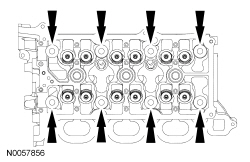
NOTICE:
Do not use metal scrapers, wire brushes, power abrasive discs or other abrasive means to clean the sealing surfaces. These tools cause scratches and gouges that make leak paths. Use a plastic scraping tool to remove all traces of the head gasket.
NOTE:
Observe all warnings or cautions and follow all application directions contained on the packaging of the silicone gasket remover and the metal surface prep.
NOTE:
If there is no residual gasket material present, metal surface prep can be used to clean and prepare the surfaces.
Clean the cylinder head-to-cylinder block mating surfaces of both the cylinder heads and the cylinder block in the following sequence.
- Remove any large deposits of silicone or gasket material with a plastic scraper.
- Apply silicone gasket remover, following package directions, and allow to set for several minutes.
- Remove the silicone gasket remover with a plastic scraper. A second application of silicone gasket remover may be required if residual traces of silicone or gasket material remain.
- Apply metal surface prep, following package directions, to remove any remaining traces of oil or coolant and to prepare the surfaces to bond with the new gasket. Do not attempt to make the metal shiny. Some staining of the metal surfaces is normal.
- Support the cylinder head on a bench with the head gasket side up. Check the cylinder head distortion and the cylinder block distortion. For additional information, refer to
Section 303-00
.


